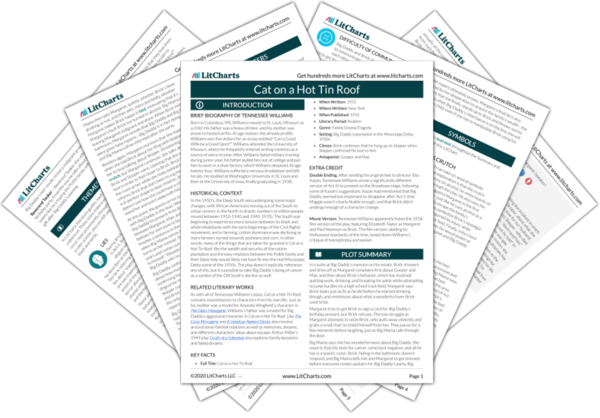Welcome to the LitCharts study guide on Tennessee Williams's Cat on a Hot Tin Roof. Created by the original team behind SparkNotes, LitCharts are the world's best literature guides.
Cat on a Hot Tin Roof: Introduction
Cat on a Hot Tin Roof: Plot Summary
Cat on a Hot Tin Roof: Detailed Summary & Analysis
Cat on a Hot Tin Roof: Themes
Cat on a Hot Tin Roof: Quotes
Cat on a Hot Tin Roof: Characters
Cat on a Hot Tin Roof: Symbols
Cat on a Hot Tin Roof: Theme Wheel
Brief Biography of Tennessee Williams

Historical Context of Cat on a Hot Tin Roof
Other Books Related to Cat on a Hot Tin Roof
- Full Title: Cat on a Hot Tin Roof
- When Written: 1955
- Where Written: New York
- When Published: 1955
- Literary Period: Realism
- Genre: Family Drama/Tragedy
- Setting: Big Daddy’s plantation in the Mississippi Delta, 1950s
- Climax: Brick confesses that he hung up on Skipper when Skipper confessed his love to him.
- Antagonist: Gooper and Mae
Extra Credit for Cat on a Hot Tin Roof
Double Ending. After sending his original text to director Elia Kazan, Tennessee Williams wrote a significantly different version of Act III to present on the Broadway stage, following some of Kazan’s suggestions. Kazan had mentioned that Big Daddy seemed too important to disappear after Act II, that Maggie wasn’t clearly likable enough, and that Brick didn’t undergo enough of a character change.
Movie Version. Tennessee Williams apparently hated the 1958 film version of the play, featuring Elizabeth Taylor as Margaret and Paul Newman as Brick. The film version, abiding by Hollywood standards of the time, toned down Williams’s critique of homophobia and sexism.







